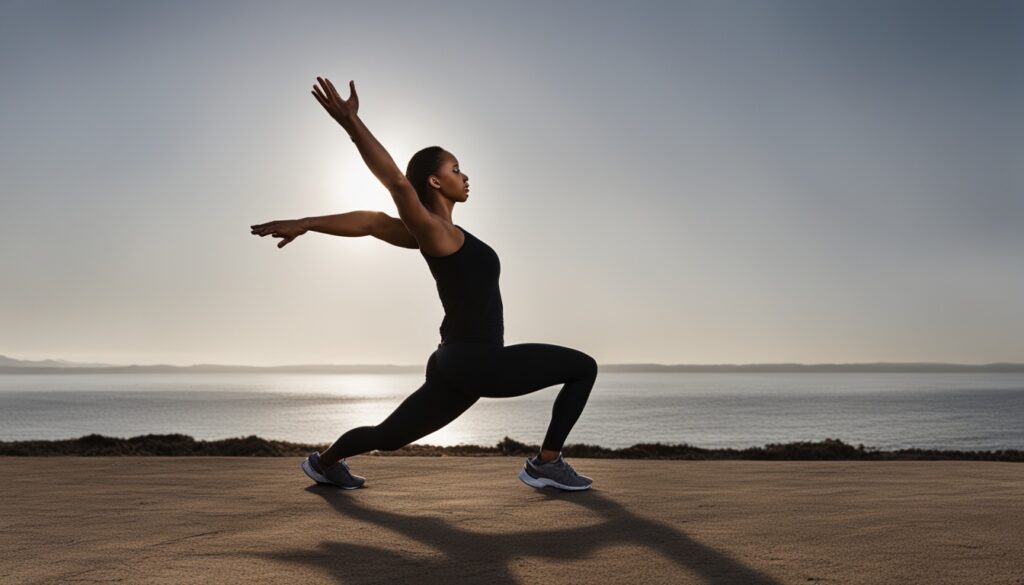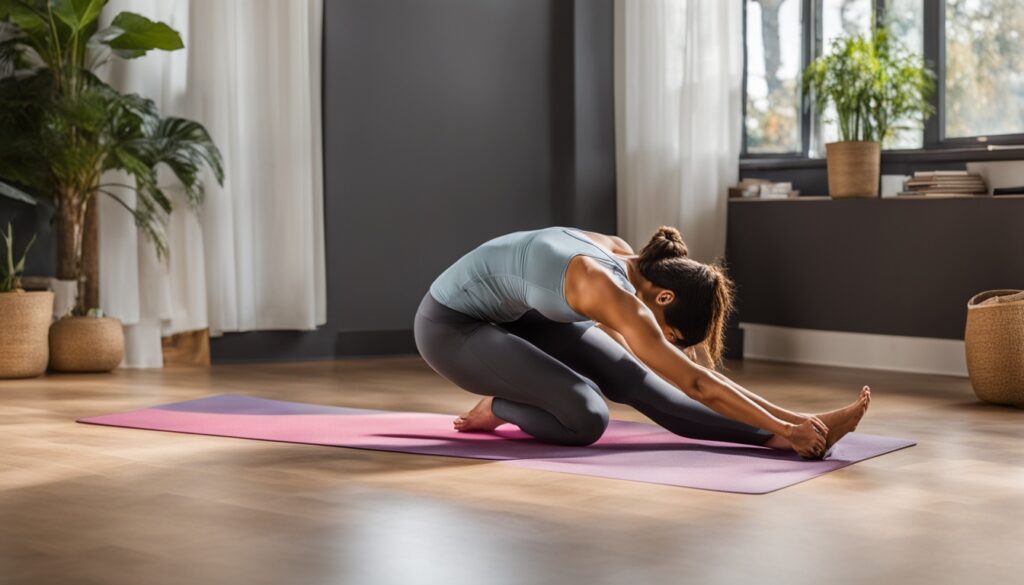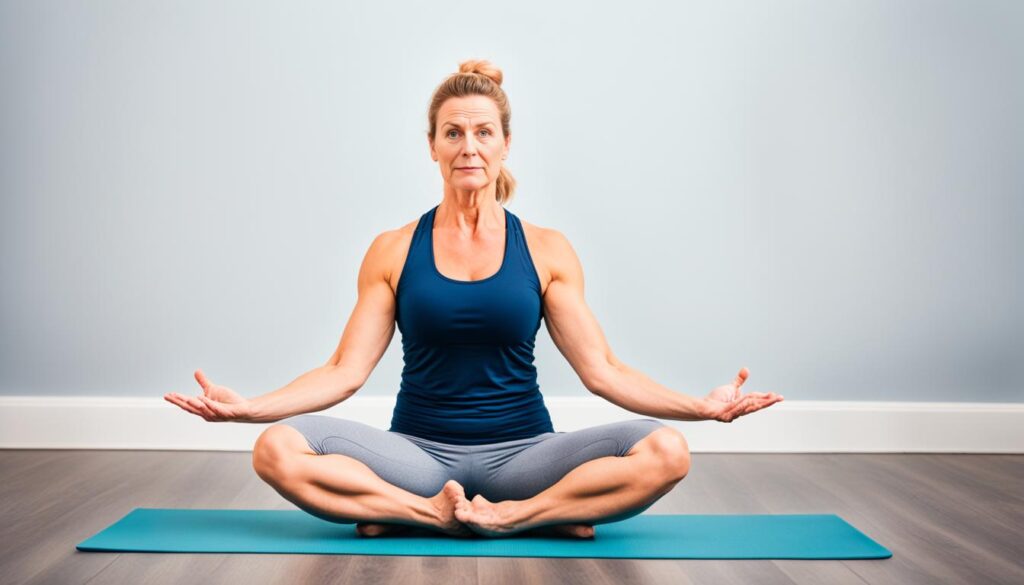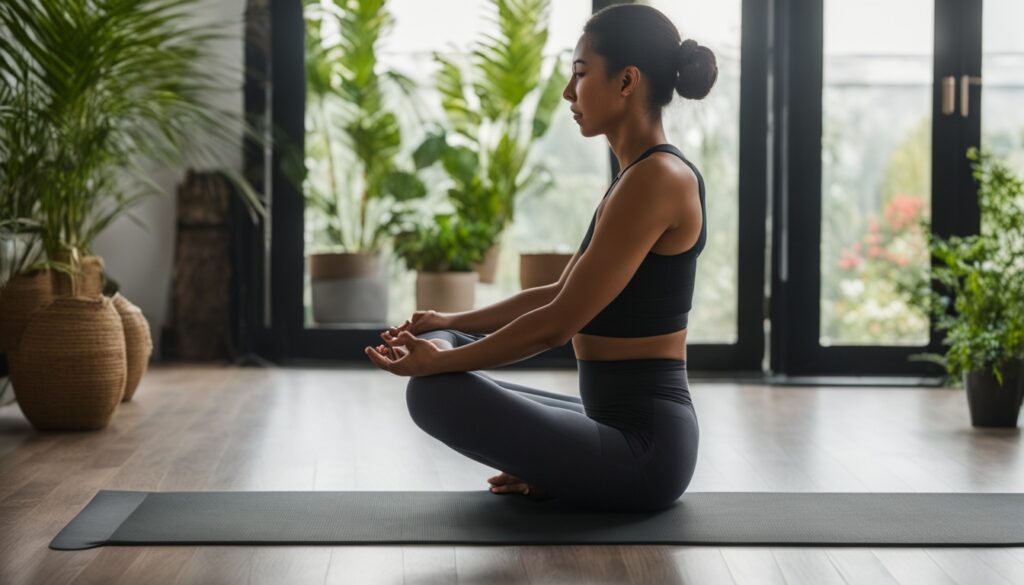Boosting flexibility is key to better mobility and health. It lowers stress on your joints. Plus, it can ease pain and boost how well you play sports. This applies whether you’re an athlete or just aiming for better daily life skills.
So, how do you get more flexible? Let’s dive into some expert advice. We’ll show you how to improve safely and efficiently.
Key Takeaways:
- Increasing flexibility is key for moving better and staying healthy.
- It eases joint stress, reduces pain, and improves sports performance.
- Getting expert advice can make your flexibility gains more effective.
Consider Foam Rolling for Flexibility
Foam rolling is great for flexibility. Studies show it increases your range of motion. It does this by boosting blood flow, increasing flexibility, and relaxing tight muscles.
When you foam roll, you use a special roller. This roller helps work out muscle tension. It focuses on specific areas to make you more flexible.
Rolling on a foam roller regularly enhances your blood flow. This makes your muscles and joints more supple. It helps bring in oxygen and nutrients while getting rid of waste.
Foam rolling also benefits your joint motion. It decreases muscle tightness that might limit your movement. Doing this, your body becomes more flexible and moves better.
How to Incorporate Foam Rolling into Your Routine
- Start with key muscles like the calves and back.
- Roll slowly over each muscle and find the tight spots.
- Press on tight spots for 30 seconds or until they relax.
- Do this for both sides of your body, giving equal time to all muscles.
- Do it before or after your workouts. You can also do it by itself.
It’s important to feel comfortable when you foam roll. Stop if you feel pain and talk to a doctor if it continues. Always adjust the pressure to suit you.
By adding foam rolling to your routine, you boost your motion range. Over time, this means better flexibility.
| Benefits of Foam Rolling for Flexibility | How It Works |
|---|---|
| Increases flexibility | Targets specific muscle groups |
| Improves circulation | Applies pressure to release tension |
| Loosens tight tissues | Enhances joint mobility |
Incorporating Dynamic Stretching into Your Routine
Dynamic stretching is about moving without holding your breath. It’s a good way to warm up that makes you more flexible slowly. Some examples include leg swings and hip openers.
Perform Static Stretching after Activity
After you’ve worked out, your muscles are ready for static stretches. Hold each stretch for 20 seconds, making sure it’s not painful. Do this a few times for each muscle group to get more flexible.
Target Areas that Need Stretching
Focus on the areas that feel tight when you stretch. Stretching these parts more will help a lot. It’s all about doing the stretches that are tough for you.
Customizing your stretching can target and boost flexibility where it counts the most.
Stretch Frequently
To gain flexibility, stretch often. Daily is best, and more if you can. This keeps you flexible and makes movement easier over time.
Stretch Safely
Being safe while stretching is key. Don’t push your body to feel pain. Stretch the muscles, not the joints. Doing it right will avoid injuries.
Improve Posture for Flexibility
Good posture helps you be more flexible. If you stand or sit straight, it lengthens your muscles. This makes you move better.
Sit on the Floor for Flexibility
Sitting on the floor is a simple way to get more flexible. It helps with hips, back, knees, and ankles. Try different sitting positions for about 15 minutes daily for the best results.
Include Flexibility in Your Workout
Don’t forget flexibility in your exercise routine. Stretching, foam rolling, and exercises like yoga all help. They not only make you flexible but also strong, improving how you move.
Incorporate Dynamic Stretching
Adding dynamic stretching to your warm-up routine is great for your flexibility and how well you move. Unlike static stretching, in dynamic stretches, you move your joints fully without stopping. This gets your blood flowing, warms up your muscles, and makes you move better.
This type of stretching is perfect to do before being active. It gets your heart rate up and wakes up the muscles you’re about to use during exercise.
Here are some dynamic stretches to add to your warm-up:
- Leg Swings: Kick one leg forward and backward next to a wall or support. This aims at your hamstrings and hip flexors.
- Hip Openers: With your feet apart, hands on hips, rotate your hips in circles. It helps to loosen up your hips.
- Butt Kicks: Jog in place while trying to touch your heels to your backside. This helps your quads and running form.
- Frankenstein Walks: Hold your arms out and walk, kicking your legs straight out. It focuses on the hamstrings and hip flexibility.
Do these stretches smoothly, without sudden movements or too much force. Try 8 to 10 reps of each stretch to get your muscles ready.
By including dynamic stretching in your routine, you can move better, make your muscles more flexible, and do better during activities.
| Dynamic Stretches | Targeted Muscles |
|---|---|
| Leg Swings | Hamstrings and Hip Flexors |
| Hip Openers | Hip Joints |
| Butt Kicks | Quadriceps |
| Frankenstein Walks | Hamstrings and Hip Mobility |

By doing these dynamic stretches, your warm-up gets better, your body can move more, and your muscles are ready for activity. Gradually adding these stretches will make you more flexible and boost your performance.
Perform Static Stretching after Activity
After a tough workout, your muscles need some love. Static stretching is a great way to help them. It boosts flexibility and muscle recovery.
This type of stretching involves holding a stretch for about 20 seconds. It lets warm muscles stretch and relax, stopping tightness. This way, your muscles can become more flexible.
Focus on stretching the muscles you worked hard. For example, if your legs got a good workout, stretch your quadriceps, hamstrings, and calves. Do each stretch 2 to 4 times for better flexibility.
Always stretch gently, without any pain. If a stretch hurts, change it or ask a fitness expert for help.
“Post-activity static stretching can help improve muscle flexibility and prevent post-workout stiffness.”
Adding static stretching after your workout can do a lot for your flexibility. So, after exercising, take a few minutes to stretch. Your muscles will thank you.
Target Areas that Need Stretching
It’s key to target areas in your body that are tight for better flexibility. By giving these parts more attention, your stretching will be more effective. This leads to better outcomes in your fitness journey.
Tight muscles often come from too much use, doing the same moves over and over, or not moving enough. This can lower how far you can move, cause pain, and might even lead to getting hurt. Focus on stretching these tight spots helps to loosen them up. It also makes you more flexible and mobile.
When you target stretch, you focus on certain muscle or body parts. This is done by figuring out which areas need the most work. Then, you can design your stretching to fit those specific needs.
Customizing Your Stretching Routine
Here’s what to think about when customizing your stretch plan:
- Check which muscles are tight: Look for places that feel tight or not moving well. This could be your hamstrings, hips, shoulders, or back.
- Find the right stretches: Search for exercises that work those tight spots. You can look online or ask a fitness expert for help.
- Start slow: Be gentle with your stretches at first. As you get more flexible, you can do more. But always stop if it hurts.
- Do it often: Try to stretch these areas every day. Doing it regularly keeps you flexible.
The stretches that are hard at first are usually the ones you need the most. Push through the tough parts to get better at them. This is how you’ll see real progress in your flexibility.

Target Stretching Examples
Here are some stretch examples for different parts:
Hamstring stretch: Sit with one leg straight and the other bent. Lean forward from the waist towards the straight leg. You’ll feel your hamstring stretching. Hold for 20-30 seconds. Then, switch sides.
Hip opener: Start in a lunge with the right foot forward, knee bent. Support yourself with your left hand on the floor. Move your weight forward to stretch your left hip. Hold for 20-30 seconds. Then, switch sides.
Shoulder stretch: Stand with your feet apart. Put one arm across your chest, holding it with the other arm. Pull the first arm towards you. This stretches your shoulder. Hold for 20-30 seconds. Then, change sides.
Don’t forget to breathe deeply and relax during each stretch. Pay attention to your form. This ensures your stretches are safe and effective.
| Target Area | Stretching Exercise |
|---|---|
| Hamstrings | Seated forward fold |
| Hips | Pigeon pose |
| Shoulders | Cross-body shoulder stretch |
Stretch Frequently
It’s important to stretch every day to get more flexible. Focus on the parts that are tight. Try to stretch those areas a couple of times throughout the day for even better results.
Adding stretching to your daily routine will help a lot. Doing it in the morning, breaks, and before sleeping works wonders. It boosts your flexibility a great deal.
Work on the areas that need it the most. It’s vital to stretch without pain. Listen to your body to avoid any discomfort. The more you stretch, the more flexible you’ll become.
Benefits of Frequent Stretching:
- Improved range of motion
- Enhanced muscle flexibility
- Better posture and alignment
- Reduced muscle tension and soreness
- Increased blood flow to muscles
Make stretching a part of your daily life for increased flexibility. Your body will feel better and you’ll thank yourself!
| Frequency | Routine | Duration |
|---|---|---|
| Morning | Stretch tight areas | 5-10 minutes |
| Midday | Take stretching breaks | 1-2 minutes per break |
| Afternoon | Stretch problem areas | 5-10 minutes |
| Evening | Relaxing full-body stretches | 10-15 minutes |
Stretch Safely
Stretching safely is key for more flexibility without hurting yourself. Use the right form and focus on stretching your muscles. This keeps your joints safe while becoming more flexible.
To stretch safely, find the muscle stretch point without pain. You should feel tension, but not hurt. Back off if it hurts. Always listen to what your body tells you.
Avoid any stretch that hurts your joints. For example, when stretching your hamstring, keep your back straight. This means no rounding your back. Use your core to keep your back in neutral position.
Using the right form is key. Make sure your body is aligned correctly and use the right muscles for each stretch. Doing this avoids injuries and hits the muscle you want to stretch best.
Remember, stretching is about getting more flexible and making your muscles move better without causing pain. It should feel nice and relaxing.
Always warm up before stretching to avoid injuries. This helps your muscles get ready for the stretches. Start with easy movements and work toward the stretches you plan on doing.
Stretching safely is the best way to improve flexibility without pain. Remember to use proper form, hear what your body says, and enjoy the safe stretch benefits.

Improve Posture for Flexibility
Good posture is key for a healthy spine and better flexibility. When your body is aligned, your muscles can stretch better. This improves flexibility.
Standing or sitting straight helps your muscles lengthen. It’s important to have your head, shoulders, and hips in line. This makes sure there’s less strain on your muscles and joints.
Keeping a proper posture puts your muscles in the best place. This improves how well your blood and oxygen move around. Good blood flow makes muscles and tissues healthier, boosting flexibility.
Practice sitting or standing straight to boost your flexibility. Keep your back straight at your desk. Relax your shoulders and keep your spine aligned.
| Benefits of Good Posture for Flexibility |
|---|
| Improved muscle lengthening and flexibility |
| Reduced strain on muscles and joints |
| Enhanced blood circulation and oxygenation to muscles |
| Prevention of muscle imbalances and injuries |
| Optimal alignment for effective stretching |
Always watch your posture, even when you sit or stand a lot. Taking breaks for stretching and yoga is good. They help keep your posture and flexibility in check.
Sit on the Floor for Flexibility
Sitting on the floor is an easy way to boost flexibility. It helps in stretching different parts of your body. This includes the hips, back, knees, and ankles. Adding floor sitting to your day can enhance your flexibility and how well you move.
Benefits of Floor Sitting
When you sit on the floor, your body moves into various positions. This dynamic action helps make you more limber. Positions like sitting cross-legged offer special stretch advantages. Let’s look at how floor sitting works:
- Hip Stretch: Sitting on the floor helps your hips move. This stretches muscles and makes them more flexible.
- Back Stretch: It keeps your spine stable while you stretch. This is good for your back and helps you stand up straight.
- Knee Stretch: Sitting on the floor eases and makes your knees move better. It helps lessen stiffness.
To get the most from floor sitting, try to sit in different ways for about 15 minutes daily. You can sit in many positions. Using cushions or blocks can make it more comfy and keep you in good shape.
Safety Considerations
Most people can do floor sitting safely. But, always pay attention to how your body feels. Don’t sit in ways that hurt, especially if you have hip, back, or knee issues. It’s smart to talk to a health expert before starting.
| Safety Tips for Floor Sitting |
|---|
| Avoid straining your joints by maintaining proper alignment. |
| Engage your core muscles to support your back and maintain stability. |
| Take breaks and change positions if you experience discomfort or numbness. |
Just remember, never force your body to stretch too much. The aim is to gently improve flexibility. Start slowly and listen to your body for lasting benefits.

Making floor sitting a part of your life helps your hips, back, knees, and ankles move better. Enjoy the benefits of being more flexible. Keep doing this simple, effective exercise to feel the difference in how you move.
Include Flexibility in Your Workout
Adding flexibility training to your routine is key for better flexibility and movement. You can do things like stretching, yoga, and dancing to get stronger and more flexible.
Stretching is vital for becoming more flexible. It boosts how far your joints can move and makes your muscles longer. Try both static and dynamic stretching to reach all your muscles.
Using a foam roller can also make you more flexible. It works out tight spots in your muscles and boosts blood flow. Doing this before and after your workouts helps you stay flexible and avoid imbalances.
Yoga is loved for mixing stretch, strength, and calm. It builds flexibility but also sharpens your balance and how you sense your body. Regular yoga means having sleek muscles and being able to stretch more.
Barre classes use tiny, muscle-focused moves to make you more flexible and strong. They’re a mix of dance, Pilates, and yoga. By taking these classes or using online guides, you can make your body more flexible in a fun way.
Pilates focuses on your core and making you steady and flexible without intense moves. It’s about doing things with care to better how you stand, balance, and move. It fits all fitness levels and boosts your flexibility a lot.
Dance is fun and does wonders for your flexibility. Any kind of dance helps you move better and in wider ways, as well as improving your coordination. Joining a dance group or taking classes adds a lively part to your workout.
By working on your flexibility in your workouts, you will move better, stay safe from injuries, and become more fit overall. Pick activities you like that stretch all your muscles well. Don’t forget to move in ways that feel good and do exercises correctly to lower the risk of injury.
So, try stretching, foam rolling, or any of the sports like yoga or barre regularly. This will boost how well you can move and keep your body in good shape.
Conclusion
Flexibility training is key to better movement and health in general. It includes many stretching methods. Each focuses on a different part of your body or health outcome. Keeping a good posture is also important.
To see your flexibility increase, be sure to stretch often. Doing so through varied methods will target different muscles. This kind of training requires you to stick with it and not give up.
Adding flexibility to your routine can expand how far your body can move. It also helps avoid getting hurt. You can stretch after a workout or warm-up with active stretching. Tools like foam rollers can also be useful for easing tightness.
Don’t forget, being steady in your efforts is crucial. Make time each day for stretching and stick to it. Starting with three or four sessions weekly is good. You can slowly increase the time and how hard you stretch.
Improvements in your ability to move and bend will follow. So, if you want to get better at sports or just feel healthier, work on your flexibility. By staying on track, you’ll experience a more supple body. This effort pays off in daily activities and your overall joy in life.
FAQ
How can I increase flexibility?
There are many ways to get more flexible. You can try foam rolling and both dynamic and static stretching. Also, pay attention to areas that are tight and stretch those spots a lot. This includes stretching often and doing it safely. It’s also helpful to work on your posture and add flexibility exercises to your regular workouts.
What is foam rolling and how does it increase flexibility?
Foam rolling is a way to use a foam roller on muscles to help blood flow, which can make you more flexible. It can make muscles less tight. Adding foam rolling to your routine is a good step towards flexibility.
What is dynamic stretching and how does it help with flexibility?
Dynamic stretching is about moving joints through their full range without holding the stretch. It’s a great warm-up that can make you more flexible. Exercises like leg swings and hip openers are examples of dynamic stretches.
When should I perform static stretching and how does it improve flexibility?
You should do static stretching after you work out, when your muscles are warm. Hold each stretch for 20 seconds and do it 2-4 times. This helps make muscles more flexible.
How can I target areas that need stretching?
Focus on the parts of your body that feel tight. The harder a stretch is, the more you might need it. Customizing your stretches for these spots can really help.
How frequently should I stretch to increase flexibility?
To get more flexible, stretch tight areas every day. If you can, do it more than once each day. This frequent stretching can improve and maintain your flexibility.
How can I stretch safely to avoid strain?
When stretching, avoid causing pain. Find the stretch in the muscle, not in joints. Using the right form is very important for safe stretching.
Can improving posture help with flexibility?
Yes, better posture can make you more flexible. Standing or sitting with your head, shoulders, and hips in line can make your muscles longer and more flexible.
How does sitting on the floor improve flexibility?
Sitting on the floor is a great way to get more flexible. It lets you move more and stretches your hips, back, knees, and ankles. Try different sitting positions, like cross-legged, for 15 minutes a day.
How important is including flexibility training in my workout routine?
Add flexibility exercises to your workouts to become more flexible. Activities like stretching, dancing, or yoga help your muscles get stronger and your body more flexible. This leads to better movement.
How can consistency improve flexibility?
Staying consistent with flexibility exercises is key to getting more flexible. Use different ways to stretch, work on tight areas, and keep your posture good. If you stretch often, you’ll see your flexibility grow over time.




















